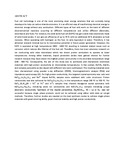| dc.description.abstract | Fuel cell technology is one of the most promising clean energy solutions that are currently being developed to help cut carbon dioxide emissions. It is an efficient way of transforming chemical energy to electrical energy without any combustion. Different types of fuel cells work on the basis of different electrochemical reactions occurring at different temperatures and utilize different electrodes, electrolytes and fuels. For instance, the solid oxide fuel cell (SOFC) has got a solid state electrolyte made of solid metal oxides. It can give an efficiency of up to 70 % with an additional 20 % attainable as heat recovery. When operating with hydrogen as the fuel, its only byproduct is water. Therefore, it has attracted research interest due to its tremendous potential in future power generation. However, the SOFC is operated at high temperatures (800 - 1000 ºC) resulting in material related issues such as corrosion which reduces the lifetime of the fuel cell. Therefore, there has been extensive research on ion conducting solid state electrolytes which has shown proton conductors to operate at lower temperatures. Among other materials, doped perovskite oxides have gained interest for further research because they have shown the highest proton conductivity in the desirable temperature range (200 - 500 ºC). Consequently, the aim of this study was to synthesize and characterize electrolyte materials with high proton conductivity at intermediate temperatures. In this context, BaTiO3, BaZrO3 and complex perovskite oxides doped with different ions were synthesized. The resulting materials were then characterized using powder x-ray diffraction (PXRD), thermogravimetric analysis (TGA) and impedance spectroscopy (IS). For high proton conductivity, the targeted crystal symmetry was cubic and BaTi0.9-xInxZr0.1O3-δ and Nd3+ doped BaTiO3 samples were stabilized with cubic structures. Proton conductivity was also achieved for BaTi0.8Zr0.1In0.1O3-δ in the temperature range 200 ºC to 350 ºC. For BaTi1-xMxO3-δ(M = Fe3+ or Fe3+ and In3+) samples they showed hexagonal crystal symmetry with BaTi0.8In0.1Fe0.1O3-δ indicating oxide ion conductivity and BaTixFe1-xO3-δ samples indicating p-type electronic conductivity. Synthesis of the double perovskites, Ba2REZrO5.5, RE = La or Eu, was not successful because single phase products could not be achieved using either solid state or sol-gel methods. Therefore, further studies are needed on the best synthesis routes to achieve single phase materials with good sintering ability, good chemical stability and high proton conductivity. | en_US |

